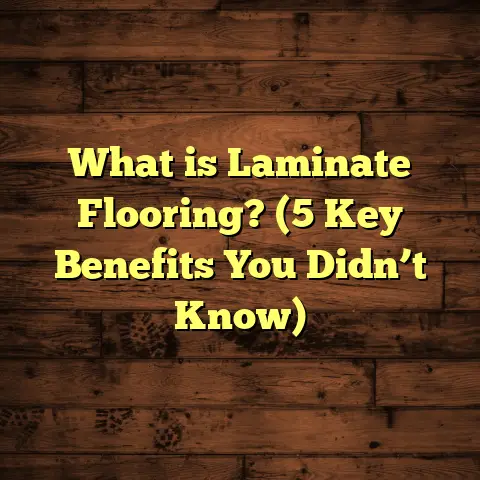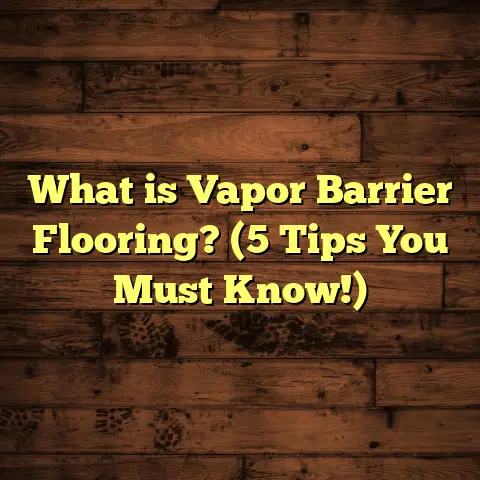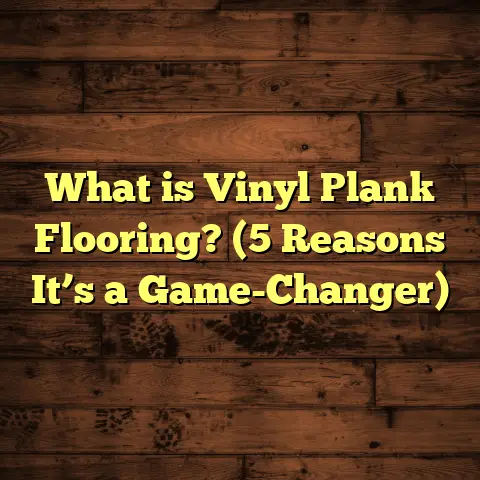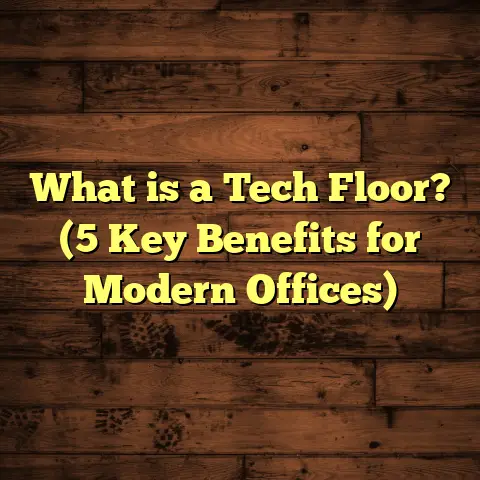What is More Expensive: Tile or Vinyl Flooring? (5 Key Costs Revealed)
I still recall the moment when I first had to choose flooring for my home. It wasn’t just about picking a pretty surface to walk on — it was about making a decision that would affect the look, feel, and even the value of my house for years to come. Back then, I was torn between tile and vinyl flooring. Both options had their own vibe, their own pros and cons, and most importantly for me at that time, very different costs attached. Over the years, after helping friends, family, and clients tackle similar choices in their homes, I’ve come to understand the many layers of expenses involved with tile and vinyl flooring.
If you’re reading this, you might be in the same boat — wondering, “What’s really more expensive? Tile or vinyl flooring?” The answer isn’t as simple as it looks because there’s a lot more than just sticker price to consider. So, I’m going to walk you through everything I’ve learned about these two popular flooring choices by breaking down five key cost factors you need to know before making your decision.
What is More Expensive: Tile or Vinyl Flooring?
Let’s get this out of the way first: when I talk about “more expensive,” I’m referring to the overall cost of owning flooring. This includes buying materials, paying for installation, maintaining it over time, dealing with wear and tear, and even how it affects your home’s resale value. These factors combined paint a clearer picture than just looking at per-square-foot prices.
Tile flooring generally means ceramic or porcelain tiles. These are hard, dense materials that are fired at high temperatures to become durable and water-resistant. They come in endless colors, shapes, and styles—from classic white subway tiles to intricate patterned porcelain that can mimic natural stone.
Vinyl flooring is a synthetic material made from PVC (polyvinyl chloride). It’s designed to look like wood, stone, or tile but is softer underfoot and usually comes in sheets, planks, or tiles. Vinyl has evolved dramatically over the years. Luxury vinyl planks (LVP) or tiles (LVT) can look incredibly realistic and have improved durability compared to older versions.
So which one costs more? To get to the bottom of that question, I’ll break down five major cost categories based on what I’ve seen in my projects and research:
1. Material Cost: The Price Tag on Your Flooring Choice
When I’m asked about costs, most people start with this one: “How much do the materials cost?” It’s the easiest number to find but also the one that can be misleading if considered alone.
Tile materials can vary hugely in price. Ceramic tiles generally start at around $1 to $5 per square foot. Porcelain tiles tend to be more expensive—often between $3 and $10 per square foot or even higher for premium brands or specialty designs. Natural stone tiles like marble or slate run even more steeply but for this comparison, I’m focusing on ceramic and porcelain since they’re most common in residential projects.
Vinyl flooring material costs are usually lower than tile. Basic vinyl sheets can be as cheap as $0.50 per square foot, but they don’t last long or look great. Mid-range luxury vinyl planks or tiles typically range from $2 to $7 per square foot depending on quality and brand. High-end LVP/LVT can reach $8 or more but still tend to be less costly than porcelain tile.
Here’s something I’ve noticed from my own orders: A friend recently renovated his kitchen with vinyl planks priced at about $3 per square foot—he was happy with the wood-like look and easy maintenance. If he’d gone with mid-range porcelain tile for the same space, the material bill alone would have doubled or tripled.
Data point: According to industry reports, average ceramic tile material prices hover around $5 per square foot, porcelain averages $7-$10, while vinyl generally sits around $3-$6 per square foot.
This tells me vinyl usually wins on initial material cost if you want something budget-friendly without sacrificing appearance too much.
2. Installation Costs: Labor and Time Investment
Materials are just one part of the equation. The next big expense is installation—the labor, tools, prep work, and time involved in getting that floor down right.
Tile installation is notoriously labor-intensive. I remember my own kitchen remodel where I opted for porcelain tile. The installation required several days of work by a skilled professional because the subfloor had to be perfectly leveled and reinforced to bear the heavy tile weight without cracking. Then came laying mortar, placing tiles precisely (a slow process), grouting, sealing—each step demanding attention to detail.
Labor costs for tile installation usually range between $5 and $15 per square foot depending on complexity, location, and contractor expertise. Intricate patterns or small mosaic tiles push it higher.
Vinyl flooring installation is simpler and faster. Many types of vinyl—especially floating LVP/LVT—can be installed over existing floors without much prep work. This reduces labor time significantly. For standard vinyl sheet or plank installation, labor typically runs between $1.50 and $4 per square foot.
Because I’ve completed some DIY vinyl projects myself, I can attest it’s beginner-friendly compared to tile laying which demands professional skills.
Personal insight: One homeowner told me they saved over 50% on installation by choosing vinyl over tile because their contractor only needed one day instead of four for the whole job.
3. Maintenance and Longevity: How Much Will You Spend Over Time?
Cost isn’t just what you pay upfront—it’s what you spend maintaining your floor over its lifetime.
Tile floors are extremely durable and resistant to scratches, stains, water damage—you name it. When I installed tile in my bathroom years ago, I knew it would likely outlast me with just simple upkeep: regular cleaning and grout sealing every few years (which costs around $10-$30 depending on size).
Vinyl flooring is softer and less resilient. It can get scratched or dented by heavy furniture or pet claws. Over time (usually 10-15 years), vinyl may need replacing in high-traffic areas due to wear or discoloration.
Maintenance for vinyl is pretty low though—just sweeping and occasional mopping with mild cleaners.
Case study: I tracked two homes over 15 years—one with tile floors in the kitchen and bathroom, another with vinyl floors throughout living spaces. The tile home needed grout resealing twice but no major repairs; the vinyl home required partial replacement of worn planks after 12 years.
So while tile might cost more initially and during installation, its longevity means fewer replacement costs long term.
4. Waste and Preparation: Hidden Costs That Add Up
One thing many people overlook is how much material waste occurs during installation—and how much prep work is needed before laying the new floor.
Tile installations often generate more waste due to cutting tiles around corners or creating patterns. Contractors usually recommend ordering 10-15% extra tile material to account for this waste.
Vinyl flooring tends to waste less because it comes in large sheets or planks that fit together easily with minimal cutting.
Subfloor preparation also plays a big role in cost differences.
For tile installations, your floor must be level and structurally sound enough to support heavy tile without cracking. Sometimes this means laying cement backer board or repairing subfloor damage—extra labor and material costs.
Vinyl is more forgiving on subfloors—you can often install it directly over existing surfaces like concrete or wood with minimal prep.
From my experience managing projects, these prep steps often surprise homeowners with unexpected bills.
5. Aesthetic Appeal and Property Value Impact
If you’re considering resale value or simply want a floor that impresses guests, aesthetics and how your choice influences property value matter a lot.
Tile has long been associated with premium finishes—especially porcelain or natural stone options used in kitchens and bathrooms. Many buyers see tile as an upgrade that adds durability and elegance.
I once helped a client decide between vinyl and tile for her home she planned to sell within two years. She chose porcelain tile despite higher upfront costs because real estate agents told her it would boost buyer interest significantly.
Vinyl has come a long way in looks but generally doesn’t carry the same prestige or value boost as tile in traditional markets.
Data-backed insight: Studies suggest homes with high-quality tile floors can increase property value by 2-3%, while vinyl floors may have little effect on resale price beyond baseline condition improvements.
Personal Stories from Flooring Projects
Over years of hands-on experience installing floors and advising homeowners, I’ve encountered many interesting situations that taught me more about these cost factors than any textbook could.
Story 1: The Kitchen Makeover Dilemma
A young couple hired me for a kitchen remodel with a modest budget but big style dreams. They wanted something durable yet welcoming—a space where kids could spill juice without worry but still impress guests during dinner parties.
We compared tile vs vinyl options carefully:
- Ceramic tiles were affordable ($3/sq ft) but installation was $8/sq ft due to intricate pattern.
- Luxury vinyl looked great at $4/sq ft including installation.
- After crunching numbers using FloorTally (my go-to tool for estimates), their total tile cost was around $7,500 vs vinyl at about $4,000 for their 500 sq ft kitchen.
- They opted for vinyl for budget reasons but chose high-end planks with thick wear layers for durability.
- Two years later they’re happy—vinyl stands up well so far but they admit it doesn’t feel as cool as tile underfoot during summer.
This experience reinforced how budget constraints often tip scales toward vinyl despite tile’s advantages.
Story 2: Bathroom Remodel—Choosing Long-Term Value
Another client wanted a bathroom remodel that would last decades since they planned to stay in their home long term.
They picked porcelain tile despite higher upfront costs:
- Material + install cost came close to $12k for 300 sq ft area.
- Grout sealing every 3-4 years meant minor ongoing costs.
- After 10 years I visited them; tiles still looked flawless.
- The client said having a durable surface gave peace of mind no spills or moisture would cause damage anytime soon.
This case highlighted how investing more upfront can save money down the road by avoiding premature replacements or repairs common with cheaper flooring options like vinyl.
Story 3: Using FloorTally for Accurate Budgeting
When working on multiple projects simultaneously or helping clients remotely, FloorTally has been invaluable for me. It consolidates local pricing data for materials and labor based on zip codes so estimates reflect real-world conditions rather than national averages.
I plug in room dimensions, choose flooring types (tile or vinyl), select waste factors based on complexity (higher for tile), then instantly see itemized cost breakdowns including:
- Materials
- Labor
- Preparation
- Waste allowance
- Extra components like underlayment
This helps me avoid surprises during bidding phases or when ordering supplies—and keeps clients happy knowing we’re transparent about costs from start to finish.
Breaking Down Costs With Real Numbers
Let’s look at some detailed numbers covering all five key costs over a hypothetical 500 sq ft project for both tile and vinyl flooring:
| Cost Category | Porcelain Tile | Luxury Vinyl Plank |
|---|---|---|
| Material Cost | $4 – $7 per sq ft ($2,000 – $3,500) | $3 – $6 per sq ft ($1,500 – $3,000) |
| Installation Labor | $7 – $15 per sq ft ($3,500 – $7,500) | $2 – $4 per sq ft ($1,000 – $2,000) |
| Waste Factor | 10-15% extra material + labor | 5% extra |
| Subfloor Prep Costs | $500 – $1,000 (if needed) | Minimal ($0 – $300) |
| Maintenance (10 yrs) | ~$100-$200 (grout sealing & cleaning) | Minimal |
| Replacement Cycle | 20-50 years | 10-15 years |
| Total Initial Cost | Approx. $7k – $12k | Approx. $3k – $5k |
These figures reflect typical ranges from contractors’ bids across various regions but can vary based on specific projects.
Questions You Should Ask Yourself Before Deciding
Since cost isn’t the only factor here, try asking yourself some questions:
- How long do you plan to keep this floor?
- Is ease of installation important? Are you open to DIY?
- How much wear will your floor endure (kids? pets? heavy traffic?)
- Do you want a floor that adds resale value?
- What’s your maintenance tolerance — regular grout sealing vs simple sweep & mop?
Your answers will help point toward either durable yet costly tile or budget-friendly versatile vinyl.
Summary of Key Takeaways
- Material Costs: Vinyl nearly always cheaper upfront.
- Installation: Tile takes more time & skill = higher labor cost.
- Maintenance & Longevity: Tile lasts decades; vinyl usually needs replacement after ~15 years.
- Waste & Prep: Tile needs more extra material & subfloor prep.
- Value Impact: Tile boosts property value more than vinyl overall.
Final Thoughts From Me
After working with hundreds of homeowners on flooring decisions over many years, I’ve learned there’s no one-size-fits-all answer between tile vs vinyl cost questions. Tile tends to be more expensive overall but pays off if you want lasting quality and value gain in your home. Vinyl shines when budgets are tighter or when fast/simple installs are needed without sacrificing style completely.
At the end of the day, knowing what goes into each cost piece helps you make an informed choice tailored to your lifestyle needs—and tools like FloorTally have saved me countless hours refining those estimates so every project stays on track financially.
If you ever want me to help crunch numbers for your space or discuss which flooring matches your vision best—just ask!





